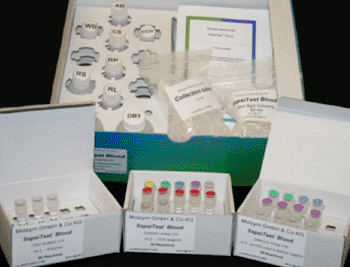Pathogen Molecular Diagnostics Evaluated for Routine Use
By LabMedica International staff writers
Posted on 24 Jun 2013
Molecular diagnosis of microbial etiologies using a universal polymerase chain reaction (PCR) and sequencing test has been evaluated in the daily routine of a diagnostic laboratory. Posted on 24 Jun 2013
The identification of bacterial and fungal pathogens using the test has been analyzed in a privately operated diagnostics laboratory, including the interpretation of the data, and the experience in performing the PCR test.

Image: The SepsiTest Kits (Photo courtesy of Molzym).
Medical laboratory scientists from the Dr. Constance Brunner Laboratory (Konstanz, Germany) examined 96 specimens originating from 66 patients under suspect of infectious endocarditis, infections of joints, encephalitis/meningitis, systemic infections, and infections of unknown origin. Samples comprised cultured and noncultured blood, synovial fluid, synovial tissue, heart valves, pacemakers, spinal tissue, cerebrospinal fluid, and swabs.
The samples were analyzed by the SepsiTest (Molzym; Bremen, Germany) and compared to culture results. Primers specific for 16S ribosomal ribonucleic (rRNA) eubacterial sequences and primers, predominantly specific for Gram-positive microorganisms (GP) were used for amplification. A third PCR was included by routine, covering predominantly the Gram-negative bacteria (GN). Pan-fungal or 18S rRNA gene-specific PCR was done on explicit request only. The 16S primers used are included in the SepsiTest kit, but GP and GN primers were ordered separately from Molzym.
The SepsiTest PCR and culture were concordant in 26 negative and 8 positive cases. A group of 25 patients was culture-negative, but PCR-positive. In at least 14 of these, common and/or rare etiologies were identified, while for 4 patients the results of 16S PCR could not be unequivocally linked with the underlying disease. Another large group of 29 patients’ samples was discordant in PCR and culture results, including 25 PCR-positive, but culture-negative, and 4 were PCR-positive and culture-positive, but with the identification result being discordant from that obtained by PCR.
The authors concluded that despite the limitations imposed on its use such as costs, false positives due to environmental contamination, SepsiTest turned out to be a tool appropriate for the diagnosis of pathogens in the clinical routine. Nevertheless, as the results show, the test cannot replace but may rather complement culture diagnosis, especially as a tool for ultima-ratio analysis. The study was published on June 7, 2013, in the journal Diagnostic Microbiology and Infectious Disease.
Related Links:
Dr. Constance Brunner Laboratory
Molzym













